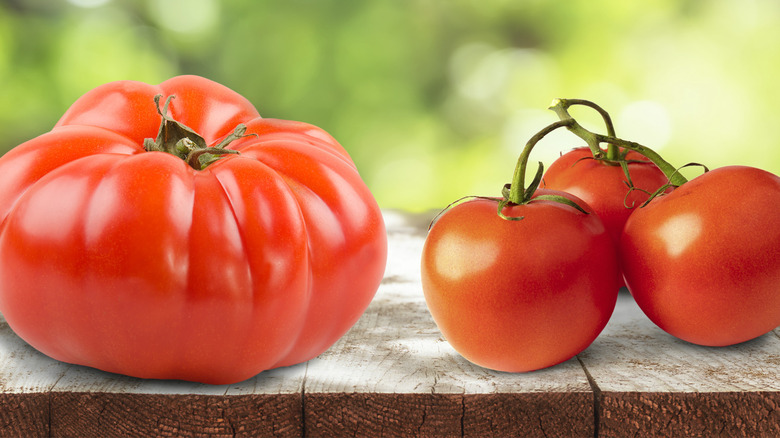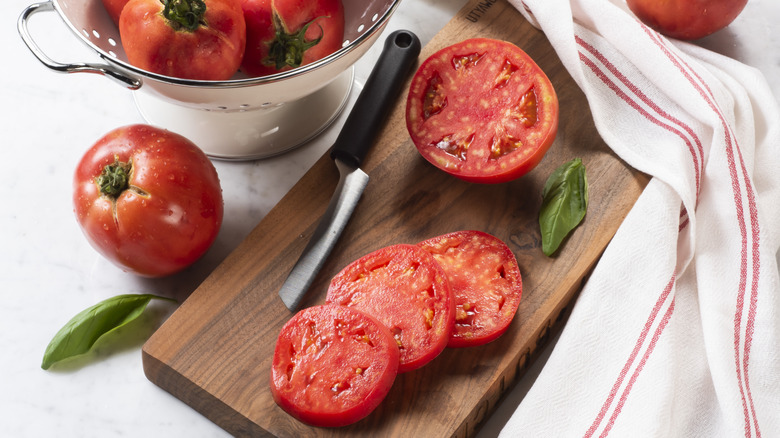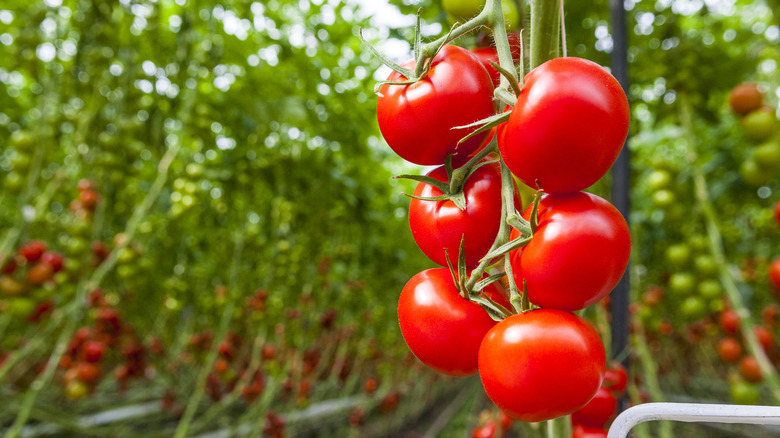Is There Really A Difference Between Beefsteak And Vine Tomatoes?
In that old classic song, discovering that "you like tomato" but "I like to-matoh" might lead to calling off a whole relationship. But picking the right tomato to share with your loved ones (no matter how you want to pronounce it) doesn't have to be so dramatic. From sunny yellow to deep black-red, tiny little bite-sized jewels to enormous, weighty globes, there are all colors, shapes, and sizes of delicious tomatoes. And although each one might be perfect for a particular recipe, we know it can be hard to choose from the options when you're at the market. Two of the most commonly available year-round larger tomatoes you'll find are the individual beefsteak tomatoes and those on-the-vine packaged tomatoes. Knowing what to expect from these two tomatoes might help make the decision easier.
Beefsteak tomato is actually a category containing several different tomato varieties, all of them larger, with more substantial fleshy interiors. These are the tomatoes you'll usually find sliced on burgers and sandwiches. Vine tomatoes are easy to spot thanks to their still attached stems, with a range of sizes from medium to smaller varieties. Nutritionally most tomatoes are equally good for you no matter the variety, providing vitamin C and antioxidants like lycopene and beta-carotene. And as we'll discover, the most flavorful tomato is a ripe tomato, no matter how they are displayed at the store.
What is a beefsteak tomato?
Beefsteak tomatoes are the category that likely comes to mind when you think of juicy, backyard, summer tomatoes. They were first tagged with that moniker in 1869 in a seed catalog, describing a variety of large tomatoes (some weighing in at a pound or more each) with firm flesh and fewer seeds that garnered comparisons to a beefsteak. The term gradually became popular with seed companies as a shortcut to designate a great slicing tomato. Thick, flavorful flesh and less of the gooey seed pockets make for a slice of tomato that doesn't fall apart when it's cut and holds up well in a sandwich.
Originally used to describe red tomatoes, the term beefsteak is now applied to a handful of varieties in all colors. You'll find heirloom yellow tomatoes, pinks, greens, stripes, and dark blackish-red hues, as well as the traditional red globes you see at your favorite hamburger joint. When you cut open a beefsteak, no matter what color, you should expect to get a beautiful presentation slice, whether you want to layer it in a sandwich or make a platter with basil and burrata cheese. But note that every individual tomato variety has its particular flavor profile — some more acid, some sweeter, some mild, and some intense. So you'll want to know more about the specific tomato.
What is a vine tomato?
Tomatoes that are sold still attached to the stem are known colloquially as vine tomatoes. Like beefsteaks, vine tomatoes can come in a number of varieties, but they might not cover your sandwich in one slice like a huge beefsteak tomato. Still, the largest of the vine tomatoes are still great for layering. The main characteristic of these tomatoes is they ripen mostly at the same time on their stem; a set of jewel-toned tomatoes with an attractive green chain connecting them. The stem is more than just for looks — possibly providing some nutrition to the tomatoes while they wait for you to eat them. The stem also provides a unique tomato aroma that makes the package more appealing.
The varieties of tomatoes that grow best for harvesting and selling on the vine are known as cluster tomatoes because of their growing and ripening characteristics; they can be picked as a cluster of fruits. A few smaller yellow tomatoes are sold on the vine, but you won't find a large choice of colors or shapes due to the current seeds available in this tomato family. You'll see some vine tomatoes grown by local farms in season, but many are grown year-round in hot houses to supply fresh tomatoes when growing conditions aren't right outside.
The visible difference is clear, but taste is everything
It's not hard to see the visual difference between beefsteak and vine tomatoes thanks to that attached stem on the latter, but when it comes to choosing the very best tomato, taste will always be king. The tomato flavor is at its peak when they're picked at just the right stage because natural sugars and flavor molecules continue to accumulate from the mother plant. A tomato picked at its full size and just beginning to change color will continue to mature, and can even be artificially ripened with ethylene gas, which mimics natural ripening to make the color change more quickly. For ease of shipping, most commercial tomatoes, beefsteak and vine included, are harvested at that color breaking point and ripened off the plant. So when it comes to flavor, the variety of tomatoes will have the most impact in most cases.
The growers of vine tomatoes say they have a slight advantage over beefsteaks because the vine continues to supply moisture to those tomatoes for a few days after picking. But vine tomatoes will never be as large as the biggest beefsteak tomatoes because of their nature. And, depending on the variety, they can have more seeds as well. Sometimes, only a large, meaty slice of beefsteak tomato will do for your BLT or tomato salad. But choose wisely — a truly ripe tomato is unbeatable.



